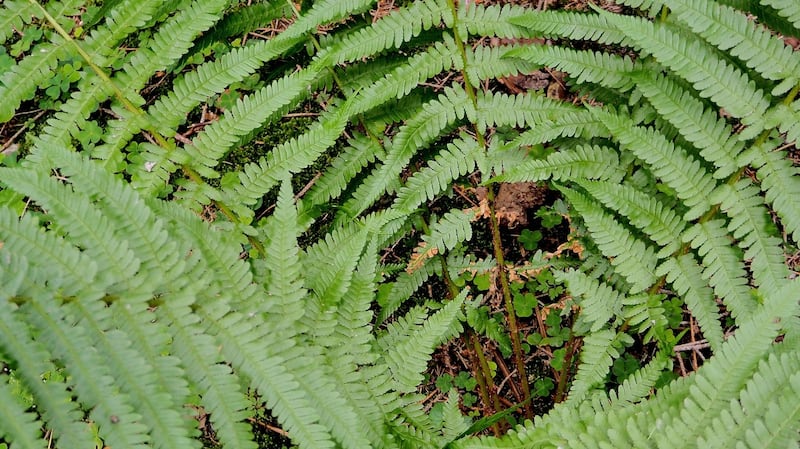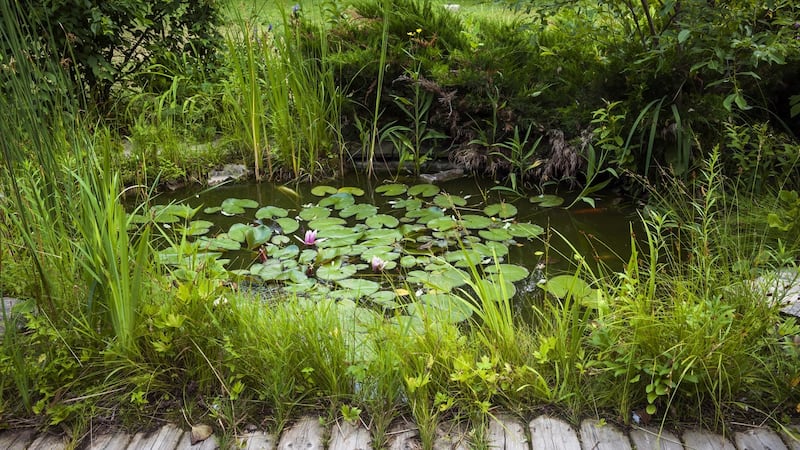Unlike us humans, a surprisingly wide range of plant species love to live in a cool, damp soil. This is, of course, great news for many Irish gardeners, especially after the record rainfall of recent months. But before you break out the champagne, a few words of caution, which is to bear in mind that a naturally damp soil is an entirely different beast to a waterlogged one.
The latter is a soil so saturated and starved of oxygen that it dramatically reduces the ability of most (but not all) species of plants to absorb nutrients. Left sitting in it for too long, their root systems inevitably rot or succumb to disease, leading to plant death.
A damp soil, by comparison, is one that retains a high degree of water but – and this part is critical – also contains enough air spaces to support plant growth. It’s the latter that’s relished by the kinds of plant species whose natural habitats in the wild include damp meadowlands and riverbanks.
It’s also important to note that there are also many different kinds of damp gardens, each with their own particular set of growing conditions. If, for example, yours is a cool woodland garden in dappled shade with a deep, humus-rich soil that typically remains damp without getting waterlogged, then you’re hugely in luck.

A host of choice garden plants will happily grow here, from spring-flowering bulbs such as snowdrops, erythronium and scillas, perennials such as trilliums, corydalis, violas, primulas, hellebores, lily-of-the-valley and many species of ferns to shrubby species such as daphne, hydrangea, rhododendron, camellia and corylopsis. For further, in-depth inspiration, get your hands on a copy of the gardening classic, The Damp Garden by the late Beth Chatto.
If, on the other hand, you garden on a heavy, claggy clay soil like so many Irish gardeners do, then it’s a different story. While naturally fertile, its tiny soil particles make it sticky, slow-draining and very inclined to waterlogging in winter, yet prone to baking hard and cracking in a dry summer. For this reason it presents a very particular set of gardening challenges and requires gentle, respectful treatment as well as a careful selection of plants.
Suitable choices include ajuga, aquilegia, day-lilies, astrantia, sanguisorba, aconitum, aruncus, many kinds of hardy geranium, eupatorium, ligularia, rheum, macleaya, berberis, escallonia, spiraea, pyracantha, weigela, flowering currant (ribes), philadelphus, cotinus, kerria, sambucus, viburnum, hydrangea, birch alder and magnolia.
To prevent problems with drainage and compaction – always a risk with any heavy clay soil – it’s also really important to avoid working or digging the ground whenever it’s wet or waterlogged. If you do have to weed/hoe it during a prolonged wet spell, then use wooden planks spread on the ground to evenly distribute your weight when walking on it.
When waterlogged soil is a recurrent problem, planting into gently raised mounds, creating raised beds or creating a gravel garden are all great solutions
These kinds of clay soils are also very prone to what’s known as “panning”, where an impermeable leathery skin forms on the surface as a result of heavy rain. In this case, use the sharp tines of a fork to spike and aerate it or – in the case of lawns – hire a mechanical aerator.
Adding plenty of well-rotted organic matter (examples include garden manure and homemade garden compost) and generous quantities of horticultural grit will also do a lot to gradually improve and aerate it. Just don’t expect instant results. Some heavy, wet clay soils are also acidic (a pH of below 7) and will benefit from the addition of garden lime. The simplest way to determine this is by using a DIY soil test kit, readily available in most good garden centres.
When waterlogged soil is a recurrent problem, planting into gently raised mounds, creating raised beds or creating a gravel garden are all great solutions. Raising the finished soil level by as little as 20cm above ground level can be the difference between happy, healthy productive plants and ones that struggle. This is especially true of alpine plants, silver-leaved, sun-loving Mediterranean species such as lavender, sage, cistus and perovskia and most fruit and vegetable crops, almost all of which need a very well-drained soil to flourish.

Gardeners with heavy clay soils can also often struggle to successfully raise plants from seed sown directly in the ground as its high moisture content and coarse, sticky texture makes it slow to heat up in spring and difficult to rake to the sort of fine, even tilth that encourages high rates of germination. Young seedlings growing in this sort of soil are also far more likely to be attacked by slugs. For this reason it’s a good idea to instead sow seed into trays/modules, transplanting the young plants out into their permanent growing positions once they’ve reached a size where they can more easily withstand attack.
Clay soils aside, some Irish gardens have areas that remain permanently wet (but not waterlogged) throughout the year. Rather than fight this, see it as a wonderful opportunity to create a bog garden, using the kinds of plants that relish these kinds of growing conditions. Examples include filipendula, ligularia, astilbe, aruncus, geum, rodgersia, zantedeschia, many species of iris, certain ferns including Osmunda regalis and Matteuccia struthiopteris, and shrubby species such as dogwoods (varieties of Cornus alba and Cornus stolonifera), Salix daphnoides and Physocarpus opulifolius. Many of these are handsome, large-leafed species that can be easily combined to create interesting contrasts of foliage and form.
Either allow your garden pool to be naturally colonised over time by native, water-loving species or fill it with a variety of aquatic plants
Last but not least are those parts of some Irish gardens that remain almost permanently waterlogged because of a naturally high water table, providing the perfect opportunity to create a wildlife-friendly pond. To make it properly waterproof, use a butyl liner or waterproof container or – for those gardening on heavy clay soil – you could do as the Victorian gardeners did and ‘puddle’ or smear the surface to create a naturally impermeable surface.
Either allow your garden pool to be naturally colonised over time by native, water-loving species or fill it with a variety of aquatic plants including oxygenators, surface-floating plants and deep water plants. Best planted in spring, all are available to purchase from good Irish garden centres and specialist nurseries.
Whichever method you choose, even the tiniest pool will hugely help to support biodiversity and encourage a wide range of wildlife to visit or take up residence in your garden from damselflies, pond skaters and water boatmen to newts and frogs, proving that even the wettest garden can be a place of great magic and mystery.












